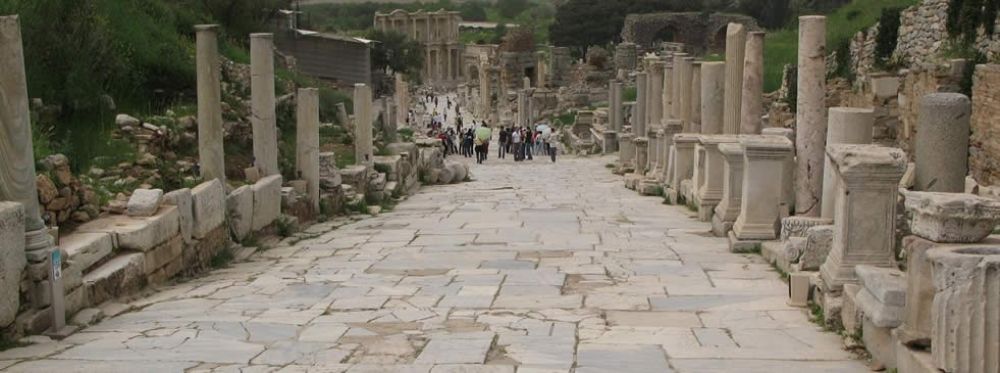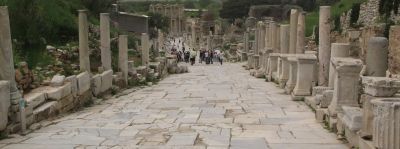

Delve into the heart of ancient civilization by walking the 2,000-year-old Curetes Street in Ephesus, Turkey. This thoroughfare was once lined with statues of the Curetes themselves - members of a sacred brotherhood. As you stroll along the marble road, you'll encounter the remains of grand colonnades, shops, and public buildings. An immersive experience awaits as you imagine the street thrumming with the activities of daily life in classical times. Marvel at the intricate mosaics and frescoes that adorn the ruins, and feel the weight of history beneath your feet with each step you take.
Adjacent to Curetes Street, the Terrace Houses offer a glimpse into the domestic life of Ephesus' wealthy citizens. Enclosed within a protective roofing structure, these multi-level homes reveal detailed frescoes, mosaics, and intricate architecture. A visit here complements the outdoor ruins with a closer look at the luxurious living quarters, complete with heating systems and private baths. A visit to the Terrace Houses is a must for any traveler interested in understanding the full spectrum of ancient life, from public to private, opulent to everyday.
This iconic facade at the lower end of Curetes Street is one of the most photographed places in Ephesus. The Library of Celsus, built to honor the Roman Senator Tiberius Julius Celsus Polemaeanus, once held nearly 12,000 scrolls, making it one of the most significant libraries of the ancient world. The two-story structure awes with its ornate columns and sculptures. As you explore, learn how the library served as a monumental tomb for Celsus, who is entombed beneath the ground floor. Spend time appreciating the architectural genius and taking memorable photographs of the reconstructed facade.
After wandering the ancient streets, visitors should venture to the nearby Ephesus Archaeological Museum in Selçuk. Here, one can find an extensive collection of artifacts excavated from the city, offering additional context to the ruins. Exhibits include statues, coins, jewelry, and daily objects that provide a deeper understanding of ancient Ephesian culture. Special highlights include the statue of Artemis, goddess of the hunt, and relics from the Temple of Artemis, one of the Seven Wonders of the Ancient World.
Venture to the Great Theatre, which dates back to the Hellenistic period and was later expanded by the Romans. With its 25,000-seat capacity, the theatre provides breathtaking acoustics and an authentic atmosphere for live performances that are occasionally held here. Being a spectator in this ancient theatre is a once-in-a-lifetime experience, offering a direct connection to the entertainment enjoyed by residents of Ephesus millennia ago. Check the local schedule for events during your visit and enjoy a performance under the stars, just as the ancients did.
As one of the well-preserved monuments in Ephesus, Hadrian's Temple contains reliefs and architectural elements that tell rich stories from Roman religion and mythology. Built in the 2nd century to honor Emperor Hadrian, this compact but fascinating structure has undergone several restorations. A visible feature on Curetes Street, it provides an interesting contrast to the residential and commercial ruins nearby. Don't miss the intricate Medusa carving meant to ward off evil spirits.
The grand Fountain of Trajan is another impressive fixture of Curetes Street. Dedicated to the Roman Emperor Trajan, the fountain once towered at nearly 20 meters high, adorned with statues and rich decorations. Though much of it lies in ruins today, you still get a glimpse of its former glory through the remaining colossal statue of Trajan, parts of which still stand. The fountain not only served as a monument but also as an essential source of water for the inhabitants of Ephesus.
The Temple of Hadrian on Curetes Street is one of the most photogenic and structurally sound remnants in Ephesus. Built in the 2nd century AD, it features an ornate archway and beautifully preserved friezes depicting scenes from the foundation of Ephesus. As you explore, note the iconic keystone of the arch bearing the head of Tyche, goddess of fortune. Despite its compact size, the temple's artistic value and historical significance make it a popular stop for visitors.
The Marble Road, adjoining Curetes Street, once served as the main artery of Ephesus and still bears the marks of ancient chariots. Walking this path is akin to stepping back in time as you tread on stones that have been polished smooth over centuries of use. Look for the etched advertisements that ancient merchants used to guide customers to their shops or attractions, including what is believed to be the world's oldest advertisement for a brothel.
In the spirit of exploring all facets of ancient life, visit the Public Latrines near Curetes Street. These communal toilets offer a humorous yet informative peek into daily life in the Roman era. Seated side by side with no dividers, the latrines reveal the Romans' social approach to what is typically a private activity today. An advanced aqueduct system flushed water beneath the latrines, showcasing ancient engineering techniques.
